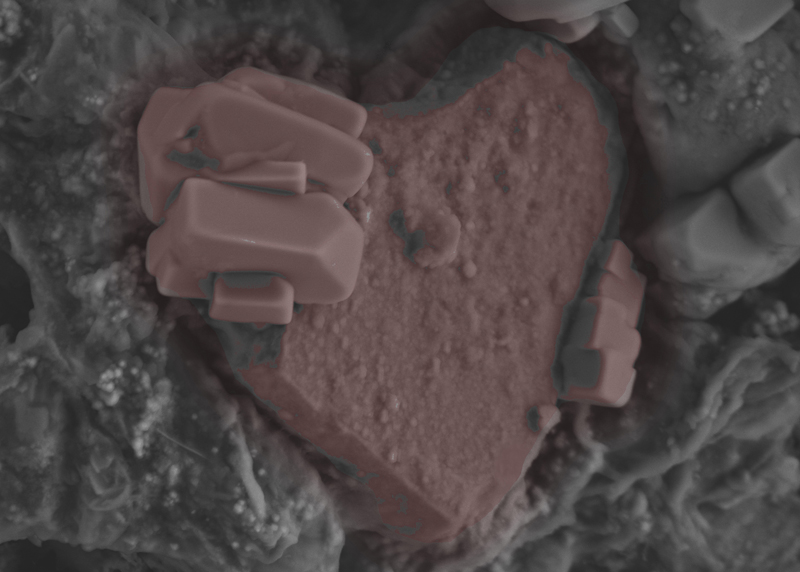Art of Science event brings visual understanding to campus research
Second annual competition to take place during Research Days in April

Digging through the Kenyan sediments, Kennie Leet found a peculiar shape of grain that, quite frankly, stole her heart.
Leet, a doctoral candidate studying sedimentology in the Department of Geological Sciences and Environmental Studies, captured her findings on a scanning electron microscope (SEM). The original photo was a muddy, green, heart-shaped feldspar grain.
“I’m really interested in patterns and various things that I see on the SEM,” Leet said. “If I see something that’s really unusual or really interesting, I always capture an image of it.”
After playing around with edits, her image became a pink heart that won her first place at Binghamton University’s first Art of Science competition in 2017.
Spring 2018 brings the competition’s second year. Students, faculty and staff may submit photographs related to Binghamton University research. The participants choose among three categories to apply their work: The World Around Us (images with visual subjects), Visualizing the Unseen (images captured via telescope and microscope) and Imagining Science (photos with objects too small to be visualized or models displaying scientific concepts and processes).
“It was so neat to walk around last year’s reception event – where entries were displayed – and it was a unique way to see work that others are doing but represented through a visual medium,” Leet said. “I think the visual representation of that is just something really unique and we don’t get to see each other’s work in that way all the time.”
The 2018 Art of Science campus reception will take place in conjunction with the beginning of Research Days Wednesday, April 18. The location is to be decided. Images must be sent to artofscience@binghamton.edu by Friday, March 2.
Event coordinator Martha Terry helped bring the event to life with the office of Research Advancement. Terry, creative services manager, describes the event as a way to bridge the gap between complex research topics and visual understanding.
“I’m not a scientist, but I communicate about science in my work,” she said. “It’s helpful to have an image as well as data and text when we’re trying to grasp a new idea.”
Last year, the contest received 67 entries from different scientific fields: psychology, electrical engineering, chemistry, geology and more. The concept was modeled after ones held at other institutions, including Princeton University.
Terry and her colleagues’ interests lie in bringing campus research to new audiences.
“So much of our thinking has to do with what we see initially,” she said. “Something might draw you to explore that specific niche or to find out more about someone’s research.”
The visual beauty of scientific discoveries, subjects and concepts helps promote the importance of research. The contest’s motto is “Science can be beautiful, too.”
According to Terry, last year’s photographs drew positive feedback from fields across the humanities and sciences, which is part of the competition’s message.
“Bringing disciplines together — it might spark some kind of interdisciplinary collaboration between professors who may not have gotten together before,” Terry said.
Even seemingly arcane scientific processes may make for visually enticing images.
An image by Andrey Dolgikh, an assistant professor of electrical and computer engineering, shows interconnected dots in colorful lines. They come from network security research created by a computer.
“The image reminds me of smoke or a sea-creature,” Dolgikh wrote in his caption.
This year, the competition features six judges from a variety of backgrounds: Surinder Kahai, associate professor in the School of Management; Blazo Kovacevic, assistant professor of art and design; Kevin E. Paredes, photography editor at Pipe Dream; Pamela Smart, associate professor art history/anthropology; Matt Mendelsohn ’85, photojournalist, portrait photographer and writer; and Ewelina Zajac-Holdrege, founder and creative director of Idea Kraft.
The prizes include a GoPro Hero5 Session for best in show and a Polaroid OneStep 2 for first place in each category.
While the Art of Science currently accepts digital photography, Terry said there must be a connection with scientific discovery. For Leet’s work, it was something as simple and recognizable as the heart-shaped mineral found within a geological work site.
“It was a scientific find under a microscope, but it had that human element or that appeal,” Terry said. “For her to have found that little heart and to emphasize it in Photoshop — that was the winner.”

